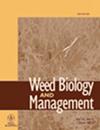Investigation on the forage utilization of indica and japonica weedy rice with strong ratooning ability
IF 1.5
4区 农林科学
Q3 AGRONOMY
引用次数: 0
Abstract
Abstract There was few research on the utilization and development of weedy rice. Some weedy rice has remarkable good characteristics as forage in some soil which is difficult to plant crops and pastures. In this study, two weedy rice lines of japonica and indica subspecies with high ratooning ability (Xijing, japonica ; Gaoxian, indica ) were used to study the possibility of their forage utilization and related suitable cultivation methods. Three different stubble heights of first season were set in 2018 and 2019, and three cutting times of first season (heading stage, milk stage, and waxy ripening stage) were set in 2019. The ratoon grass was harvested 40 days after the first season harvest. For japonica weedy rice line Xijing, its grass yield was significantly lower than that of indica weedy rice line Gaoxian. The dry matter yield of first season grass plus ratoon grass of Gaoxian with the first season harvested at milk stage was the highest of all. The total digestible dry matter yield (first season grass plus ratoon grass) of Gaoxian with 15 cm cutting stubble of first season was higher than those of stubble 30 and 45 cm treatments ( p < .05). In conclusions, indica weedy rice line Gaoxian, with high biomass of first season and good ratooning ability, had the good potential for forage development by harvesting first season at milk stage with 15 cm stubble height.再生力强的籼、粳杂草稻的饲用研究
摘要杂草稻的开发利用研究较少。一些杂草稻在一些难以种植作物和牧草的土壤中具有显著的牧草特性。本研究选用再生能力强的粳稻和籼稻亚种2个杂草水稻品系(西粳、粳稻;以高仙、籼稻为研究对象,研究其牧草利用的可能性及适宜的栽培方法。在2018年和2019年设定了3个不同的首季茬高,2019年设定了首季(抽穗期、乳期和蜡熟期)的3个刈割时间。在第一季收获后的第40天收获青叶草。粳稻杂草品系西粳的产草量显著低于籼稻杂草品系高先。第一季草和高县次生草的干物质产量最高,第一季收获在乳期。高县第1季割茬15 cm的总可消化干物质产量(第1季草加再生草)高于茬30和茬45 cm处理(p <. 05)。综上所述,籼型杂草稻品系高先首季生物量高,再生能力好,在乳期首季收获,茬高15 cm,具有良好的牧草开发潜力。
本文章由计算机程序翻译,如有差异,请以英文原文为准。
求助全文
约1分钟内获得全文
求助全文
来源期刊

Weed Biology and Management
农林科学-农艺学
CiteScore
2.70
自引率
0.00%
发文量
13
审稿时长
>36 weeks
期刊介绍:
Weed Biology and Management is an international journal, published four times per year. The journal accepts contributions in the form of original research and review articles in all aspects of weed science. Contributions from weed scientists in the Asia–Pacific region are particularly welcomed.
The content of the contributions may relate to weed taxonomy, ecology and physiology, weed management and control methodologies, herbicide behaviors in plants, soils and environment, utilization of weeds and other aspects of weed science. All contributions must be of sufficient quality to extend our knowledge in weed science.
 求助内容:
求助内容: 应助结果提醒方式:
应助结果提醒方式:


